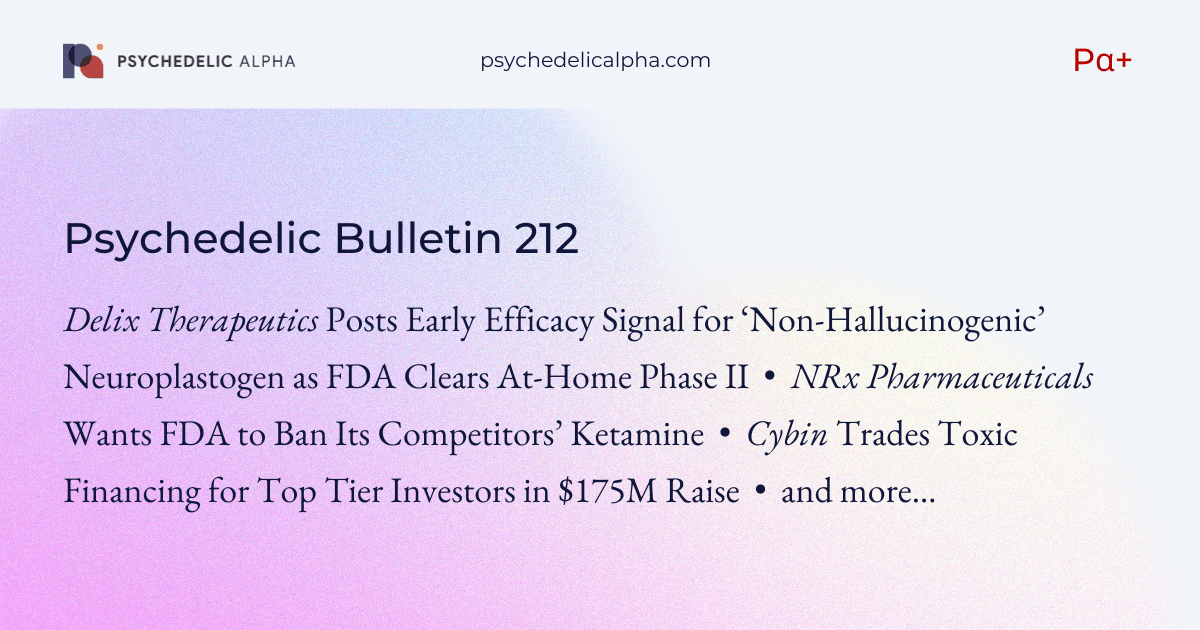In this Issue
- Delix Therapeutics Posts Early Efficacy Signal for ‘Non-Hallucinogenic’ Neuroplastogen as FDA Clears At-Home Phase II
- NRx Pharmaceuticals Wants FDA to Ban Its Competitors’ Ketamine
- Cybin Trades Toxic Financing for Top Tier Investors in $175M Raise
- and more…
***
Delix Posts Early Efficacy Signal for ‘Non-Hallucinogenic’ Neuroplastogen as FDA Clears At-Home Phase II
On Tuesday, Delix Therapeutics announced positive topline data from a small Phase Ib study of DLX-001 in major depressive disorder (MDD). DLX-001, also known as zalsupindole, is an analog of 5-MeO-DMT that the company describes as a non-hallucinogenic neuroplastogen.
18 patients were dosed with DLX-001, either once daily for seven days or twice during the seven-day period. The company reports a 12-point drop on the MADRS at day 8. It further reports that these effects were sustained through day 36.
Both dosing regimens fared similarly well in terms of antidepressant effects and tolerability, Delix noted, and there were no serious adverse events, and no “hallucinatory, dissociative or psychotomimetic effects” were reported. The company is clearly eager to distance itself from psychedelic effects.
The company also emphasised what it describes as “[r]obust translational biomarkers”, like quantitative EEG and polysomnography. It says it will share results on this front at conferences.
A recent publication by Delix-affiliated scientists described the pharmacology of the drug in mice. That paper, researcher Alex Kwan says, “was really compelling.” “It showed that zalsupindole promotes structural neural plasticity in a dose-dependent way, with both positive and negative controls in place”, he told Psychedelic Alpha, adding: “The structural findings were further reinforced by electrophysiological data.” Now, the company will hope to prove that this animal work translates to humans.
Delix now plans to launch a multi-site randomised placebo-controlled Phase II study, for which it has received IND clearance. The three-arm study sees patients receive either placebo, daily dosing, or twice-weekly dosing.
Notably, FDA has signed off on at-home dosing, with patients expected to self-administer the oral drug outside of the trial site setting…
To continue reading this Issue of the Psychedelic Bulletin, please sign in or join Pα+ today…
Join Pα+ Today
Independent data-driven reporting, analysis and commentary on the psychedelics space: from business and drug development through to policy reform and culture.
Already a member? Log In
✓ Regular Bulletins covering key topics and trends in the psychedelics space
✓ Regular articles and deep dives across psychedelic research, policy and business
✓ Interviews with insiders
✓ Monthly interactive database and commentary on psychedelic patents
✓ Quick-take analysis of major developments
✓ A Library of primers and explainers
✓ Access to our full back catalogue


